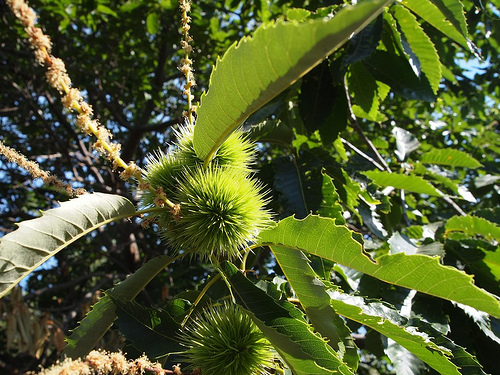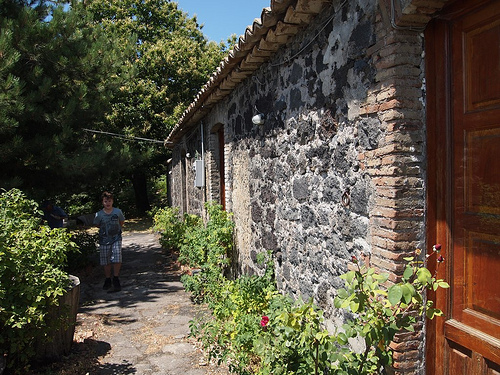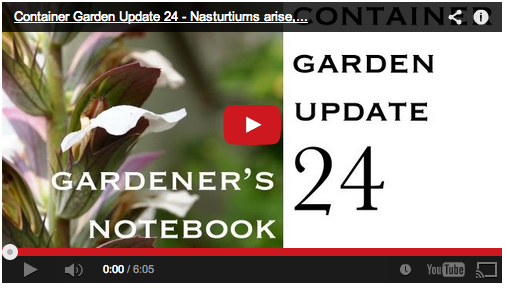Chestnut (Castenea)
I am going to guess that these photos shows a Castenea saliva or Sweet Chestnut as they are older trees in rural Sicily, on the flanks of Mount Etna. We were visiting and old farmhouse that once was surrounded by orchards midway up the flanks of the volcano. These chestnut trees were quite large and producing a bountiful crop.
Chestnuts have often been staple food of the poor throughout Europe. People would eat both the whole nuts, roasted, but they could also be ground into a nearly gluten-less flour which could be backed into flatbreads, fritters and cakes.

Chestnuts growing in mid-summer, Mount Etna, Sicily

You can see one of the chestnut trees in the background of this photo
The name “Chestnut” is derived from an earlier English term “Chesten nut”, which descends from the Old French word “chastain” (Modern French, châtaigne).[11]
The trees’ names are virtually identical in all the most ancient languages of Central Europe: in Breton kistinen for the tree, and kistin for its fruit, in Welsh castan-wydden and sataen, in Dutch kastanje for both the tree and its fruit, in Albanian gështenjë, and many others close to the French châtaigne and to the Latin name chosen for the genus, Castanea.[12]
The name Castanea is probably derived from the old name for the sweet chestnut, either in Latin[13] or in Ancient Greek. Another possible source of the name is the town of Kastania in Thessaly, Greece;[5] more probable, though, is that the town took its name from the most common tree growing around it.[12] In the Mediterranean climate zone, chestnut trees are rarer in Greece because the chalky soil is not conducive to the tree’s growth. Kastania is located on one of the relatively few sedimentary or siliceous outcrops. They grow so abundantly there, their presence would have determined the place’s name.[14] Still others take the name as coming from the Greek name of Sardis glans (Sardis acorn) – Sardis being the capital of Lydia, Asia Minor, from where the fruit had spread.[15]
The name is cited twice in the King James Version of the Bible. In one instance, Jacob puts peeled twigs in the water troughs to promote healthy offspring of his livestock.[16] Although it may indicate another tree, it indicates the fruit was a local staple food at that time.[12]
These synonyms are or have been in use: Fagus castanea (used by Linnaeus in first edition of Species Plantarum, 1753),[17] Sardian nut, Jupiter’s nut, husked nut, and Spanish chestnut (U.S.).[18]
The sweet chestnut was introduced into Europe from Sardis, in Asia Minor; the fruit was then called the ‘Sardian nut’.[18] It has been a staple food in southern Europe, Turkey and southwestern and eastern Asia[8][29] for millennia, largely replacing cereals where these would not grow well, if at all, in mountainous Mediterranean areas.[30] Evidence of its cultivation by man is found since around 2000 B.C.[31] Alexander the Great and the Romans planted chestnut trees across Europe while on their various campaigns. A Greek army is said to have survived their retreat from Asia Minor in 401–399 BC thanks to their stores of chestnuts.[32] Ancient Greeks like Dioscorides and Galen, wrote of chestnuts to comment on their medicinal properties—and of the flatulence induced by eating too much of it.[33]To the early Christians, chestnuts symbolized chastity.[16] Until the introduction of the potato, whole forest-dwelling communities which had scarce access to wheat flour relied on chestnuts as their main source of carbohydrates.[8] In some parts of Italy, a cake made of chestnuts is used as a substitute for potatoes.[5] In 1583, Charles Estienne and Jean Liébault wrote that “an infinity of people live on nothing else but (the chestnut)”.[34] In 1802, an Italian agronomist said of Tuscany that “the fruit of the chestnut tree is practically the sole subsistence of our highlanders”,[35] while in 1879 it was said that it almost exclusively fed whole populations for half the year, as “a temporary but complete substitution for cereals”.[36] — Wikipedia.org
Previously in the Interesting Plant series:
- Camellia japonica ‘Anemoniflora’
- Zaluzianskya villosa “Southern Lilac Drumsticks”
- Prickly Pear Cactus (Opuntia)
- Campanula
- Rudbeckia
- Caladium bicolor ‘White Queen’
- Fuchsia
- Palo Verde Tree (Parkinsonia florida)
- Espalier Fruit Trees
- California Poppy (Eschscholzia californica)
- Hydrangea ‘Zorro’
- Harlequin flower (Sparaxis tricolor)
- Erythronium
- Sempervivum
- Primula auricula
- Feathery Cassia (Senna auricula)
- Red Stick Dogwood (Cornus alba ‘Sibirica’)
- Japanese Maple (Acer palmatum)
- Kousa Dogwood (Cornus kousa)
- Giant Chalk Dudleya (Dudleya brittonii)
- Sunrose (Helianthemum nummularium)
- Australian/New Zealand Tea Tree (Leptospermum scoparium)
- Brugmansia Sanguinea
- Calico Monkeyflower (Mimulus pictus)
- Colocasia Esculenta
- Acer palmatum ‘Sango-kaku’ (Coral Bark Japanese Maple)
- Linderniaceae (formerly Torenia) Kuaui Deep Blue
- Passiflora (Passion flower)
- Firewheel Tree (Stenocarpus sinuatus)
- Anemone
- Allium Cowanii
- Symphyotrichum oblongifolius (Purple Aster)
- Hemerocallis ‘Derrick Cane’ (Daylily)
- Agastache ‘Aztec Rose’
- Rudbeckia hirta Moreno
- Kalanchoe Tomentosa
- Albuca namaquensis
- Hosta ‘Remember Me’
- Dahlia ‘Clair de Lune’
- Lovely silver-tinged fern on campus of Oberlin College, Ohio
- Tricolor Beech (Fagus sylvatica Purpurea Tricolor)
- Climbing Hydrangea (Hydrangea anomala petiolaris)
- Eremurus ‘Lemon Meringue’
- Lupine “Sunrise” (Lupinus hartwegii)
- Chinese Fringe Flower (Loropetalum chinense)
- Streptocarpus ‘Harlequin Blue’
- Nigella damascena (love-in-a-mist, ragged lady)
- Epiphyllum (Orchid Cactus)
- Sempervivum ‘Westerlin’
- Gladiolus ‘Kings Lynn’
- Hosta sieboldiana ‘Dorothy Benedict’
- Begonia “Escargot”
- Asparagus Pea (Psophocarpus tetragonolobus)
- Rosa banksiae (Lady Banks’ Rose)
- Primula ‘Victoriana Silver Laced Black’
- Oxalis versicolor
- Poached Egg Plant (Limnanthes douglasii)
- Parisian Carrots
- Fritillaria imperialis Rubra Maxima
- Clematis “Fascination”
- Swiss Chard “Bright Lights”
- Georgia Rattlesnake Melon
- Dianthus Barbathus “Green Ball” or “Green Trick”
- Coleus “Religious Radish”
- Black Forest Calla Lily
- Black Bamboo
Interesting Plant is a series from A Gardener’s Notebook blog and podcast that highlights the most interesting plants I find in my Internet and real-world travels — Douglas





